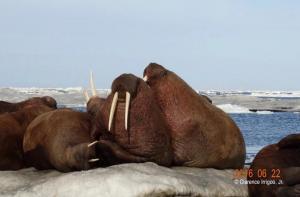How can we support safe navigation in sea ice and food security for Alaskan subsistence hunters in a rapidly changing and less predictable Arctic?

Who Cares and Why?
The Sea Ice for Walrus Outlook (SIWO; https://www .arcus.org/search-program/siwo) is a resource for Alaskan Native subsistence hunters and coastal communities of Alaska’s Bering Strait region that provides weekly reports on spring sea ice and weather conditions to promote hunter safety and preservation of cultural heritage. SIWO integrates weather and ice forecasts, satellite imagery (NASA MODIS, SNPP VIIRS and Sentinel-1a & -1b SAR), and local observations from Alaska Native community members.
The SIWO effort uses science—predictive models, forecasts, and satellite images—to directly address the needs of coastal communities. One of the primary coastal challenges we seek to address is the effect of rapidly changing and less predictable sea ice and weather patterns on subsistence communities. The Arctic is warming disproportionately fast compared with lower latitudes. During the past decade, we have witnessed record-setting declines in the seasonal sea ice upon which many Arctic-dwelling species depend. Long-standing, traditional ways of understanding and reading weather and ice conditions have become less reliable as never-before-seen conditions have become commonplace.
Needed Measurements
Visible satellite imagery along with Synthetic Aperture Radar (SAR) satellite imagery produce quality observations of sea ice position and concentration, which provides useful information to local communities, subsistence hunters, and decision-makers. While the visible satellite images provide consistent coverage over Alaskan waters, the view of sea ice on the ocean surface is oftentimes partially blocked by cloud cover. SAR imagery is not limited by cloud cover like the visible imagery, however the data is limited in coverage over areas relevant to SIWO. The combination of these various satellite resources typically provides a high to moderate confidence in sea ice position and sea ice concentration, however interpretation of sea ice thickness can be a larger challenge. Sea ice thickness is typically identified using the World Meteorological Organization standard categories (new, young, first year thin, first year medium, first year thick, and multiyear). These categories are determined by sea ice analysts based on the visible characteristics of the sea ice from satellite, outputs from a sea ice forecasting model (ACNFS), the forcing dynamics of the pack ice (polynyas, pressurized sea ice on a coastline), and observations submitted from the field. While each of these sources contributes to the analysis of sea ice thickness, the ICESat‐2 satellite observations will likely provide an additional resource to improve upon current observations and enhance our current capabilities to understand sea ice thickness.
The NASA Response
Launching no later than fall of 2018, the ICESat-2 mission will use a 6-beam LIDAR to measure surface elevation across the globe. The micro-pulse, multi-beam Advanced Topographic Laser Altimeter System (ATLAS) will enable global, seasonal and high-resolution observations and understanding of sea ice conditions. The small footprints of ATLAS (~15m) combined with dense along-track spacing (~70 cm), precision elevation measurements (< 10cm over most surfaces) and geolocation knowledge (data located on earth’s surface to < 6.5m) will allow ICESat-2 data to be used as a primary data source for sea ice freeboard measurements and estimation of sea ice thickness. It is expected that ICESat-2 will lead to significant improvements in forecasts for the entire Arctic domain, including forecasts of ice conditions produced by the U.S. Navy’s ACNFS operational system as is being investigated by the Naval Research Laboratory (ICESat-2 Early Adopter, PI: Pam Posey).
Comments? Thoughts?
For information about this particular application, contact Lisa Sheffield Guy at lisa@arcus.org
For additional information about ICESat-2 mission applications, please contact Sabrina Delgado Arias at: sabrina.delgadoarias@nasa.gov


